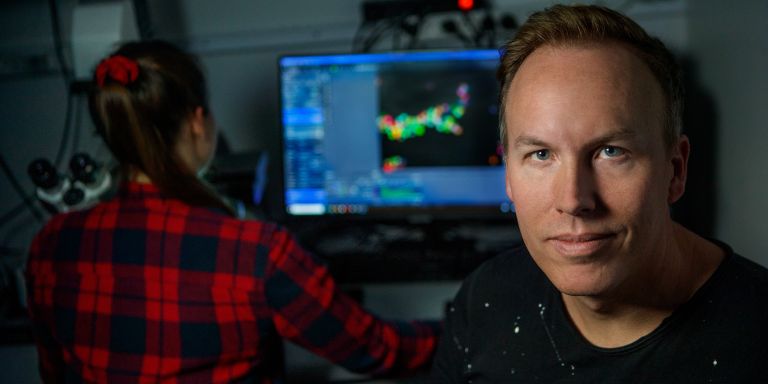
Rickard Sandberg
Professor of Molecular Genetics
Wallenberg Scholar
Institution:
Karolinska Institutet
Research field:
The impact of synaptic proteins on brain function


Wallenberg Scholar
Institution:
Karolinska Institutet
Research field:
The impact of synaptic proteins on brain function
Humans have approximately 20,000 genes that give rise to about 100,000 proteins, with the majority of our genes contributing to more than one protein. This process is called splicing and results in multiple protein variants with different traits. As a Wallenberg Scholar, Sandberg aims to map the role of splicing in the development of the brain’s neurons.
“This is actually the first time I've worked on the brain. But we’ve been developing our methods for a long time. Splicing is a field I began exploring even when I was a postdoc,” says Sandberg.
When Sandberg founded his research lab in 2008 it was not possible to see which genes were active in a single cell. His research resulted in a method known today as single-cell analysis, or single-cell RNA sequencing, which is now used worldwide.
“The use of single-cell RNA sequencing has exploded over the last decade, producing enormous amounts of information. However, almost no research has been conducted on splicing, largely due to a lack of effective techniques.”
Earlier computational methods required researchers to know which protein variants they were looking for. Sandberg’s research team has now developed a method that requires no such prior knowledge.
Recent research suggests that splicing probably plays a vital role in the development of brain synapses. Yet we still lack an understanding of how splicing is regulated in different types of cells.
“We want to ascertain whether there is an underlying molecular splicing code, how it governs the ability of synapses to establish contact, and the impact it has on electrical signal transmission between neurons,” says Sandberg.
The research team also aims to find out when the molecular splicing code develops in cells and how stable it remains over time. They are therefore comparing findings in cells at different stages of development.
The mapping process has begun with data the team has already gathered. The next step is to expand into new regions of the brain. The research is highly interdisciplinary and requires a team with expertise ranging from AI and genetics to molecular biology.
When the researchers map protein variants, they also record which synapses are in contact with each other. This work is being carried out in collaboration with Konstantin Meletis, with the goal of understanding how splicing impacts the structure of the brain’s networks.
“To achieve this, we use an inactivated rabies virus with a limited ability to jump between synapses in the brain. This method allows the virus to leave a trace that we can follow to create a map of which synapses are connected to each other.”
Finally, the research team hopes to investigate whether different protein variants can also predict the electrophysiological properties of neurons. They have previously developed a method – patch-seq – that allows the integration of data on electrical properties, morphology and gene expression.
If you have the opportunity, it’s important as a researcher to take on the problems you find most interesting.
“If we can ascertain how different variants of synaptic proteins affect brain function, we will be a step closer to understanding various neurodegenerative and mental disorders. These are strongly linked to genetic changes in the brain.”
Sandberg does not shy away from new challenges. On the contrary, he is keen to venture into uncharted territory.
“When I started my research team, I sought funding to develop a new method to address a problem I had never studied before: how an embryo develops. Developing single-cell RNA sequencing seemed like a logical step at that time,” he says.
The splicing project began as a secondary line of research. But when he realized how few others were exploring this field, it quickly gained momentum.
“When I read up on it, I understood its central role in the development and function of neurons and that it requires the kind of large-scale approach we have adopted.”
His career has progressed rapidly since his days as a postdoc. At the age of 38, he became a professor and is one of the youngest members of the Royal Swedish Academy of Sciences.
“Perhaps I have a tendency to take on a bit too much, but I do enjoy staying busy. And it's important to spread knowledge about research to a wider audience.”
He is driven by curiosity as well as a competitive spirit. In his free time, he enjoys racket sports and happily accepts challenges from his colleagues.
“Racket sports are a great way to exercise, and we’ve had various challenges in the lab. So far, no one has beaten me at squash, badminton, table tennis or tennis, so the challenge still stands,” says Sandberg.
Text Magnus Trogen Pahlén
Translation Maxwell Arding
Photo Magnus Bergström